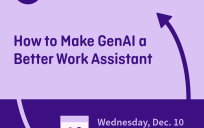Journey maps are one of the most effective and perhaps underutilized ways of understanding what constituents experience and how best to serve them. The maps help agencies set priorities, allocate resources and identify process improvements, and they help ensure that government services are accessible and seamless. Here’s how journey maps work.
Key Definition: User Personas
Generalized, research-based profiles of key customers that capture what an agency knows about its audience. Personas tell stories, and an agency might need to create multiple personas if targeting more than one demographic for the same product or service. For instance, when GSA helped USDA develop Farmers.gov, it created three personas: Fred, an experienced producer; Amelia, a beginning producer; and Bob, a loan officer.
What Is a Journey Map?
It’s a visual, data-driven tool that shows the stages a customer must go through when interacting with an agency — e.g., to apply for healthcare benefits — including psychological and emotional responses along the way. Journey maps typically feature graphics, multiple colors and some combination of charts and diagrams, but all journey maps reflect four things:
- The steps needed to achieve a goal, including official procedures, workarounds and incidental steps
- Specific actions and decisions the customer must make
- Touch points, or ways the person interacts with an agency and its systems, such as through in-person meetings, text messages, email, website content or phone calls
- The person’s emotions, both positive and negative, throughout the journey
8 Tips for Creating an Effective Journey Map
1. Get Leadership Buy-in
Journey maps can identify important opportunities to improve CX, but if leadership is unwilling to solve the problems a journey map clearly shows, then the maps become an exercise in futility. And if executives won’t commit the time and resources needed for effective journey mapping, then consider: Is a half-hearted map worth pursuing?
2. Define the Objective and Scope
Sounds obvious, but what are you trying to accomplish? What insights you are aiming for? Know in advance who will use the findings and how, and to avoid distraction and mission creep, make sure the journey has a clear beginning and end.
3. Use the Right Data
You should base your user personas on trusted data from a variety of sources. Frontline personnel can offer important anecdotes, but website analytics, focus groups, surveys, and social media feedback, for instance, also are important. Walk in a customer’s shoes.
4. Flesh Out Personas
The data will reveal common themes that help you build individual personas — e.g., a 65-year old widower who lives in a city and has limited broadband access. Different aspects of a persona may be more meaningful for some teams than others based on each team’s primary objective.
5. Map the Stages
Plot the stages of the journey from start to finish and tie each stage to a specific goal. For example, an initial stage might be when a customer realizes they need a service. The next stage would be researching the service, followed by applying for it, using it, etc.
6. Add Step-By-Step Detail
Based on data, identify the steps a customer would take within each stage and how the person likely would interact with your agency at those points. If you think about someone researching a service, for instance, the person probably will search online and wind up on your agency website, where they will click on links to specific information that will take them, perhaps, to an online form. Your journey map also must capture what the customer is thinking and feeling when taking those actions; that way, the map shows more than just the process. For example, is the person frustrated because they had to click four different links on your website before getting to the signup form? Journey maps often are lengthy and complex, and one reason is because detail makes the maps worthwhile.
7. Identify Areas for Improvement
Fleshing out the customer’s journey should reveal pain points you can alleviate. Once you identify problem areas, brainstorm possible solutions and present them to stakeholders and to leadership who can ensure their execution. Perhaps you can make it easier for people to find a registration form on your website or maybe you can shorten call-center wait times. If it’s helpful, think about what the ideal customer journey would look like.
8. Fine Tune Data Over Time
Journey mapping is a process that never ends. Your maps should evolve over time, updated to reflect new data, technology, and agency improvements; new metrics will show if your reforms are bearing fruit. Mapping won’t solve your CX problems, but it will help you identify and understand them.
Examples to Guide You
You don’t need to create a journey map from scratch: There are both free and vendor-available templates to start from, and sometimes a simple Microsoft Excel spreadsheet is a good way to begin. But to give a sense of what’s possible, here are some government-specific maps for reference.
Performance.gov: Transitioning to Adulthood
Performance.gov: Surviving a Natural Disaster
Agriculture Department (USDA): Direct Farm Loans Journey Map
Department of Housing and Urban Development: Affordable Housing for Seniors Journey Map
Veterans Affairs Department: Journeys of Veterans Map
Georgia Technology Authority: Journey Map Resources/Template
This article appeared in our guide, “CX: Reaching People Where They Are.” To find out more about how agencies are improving their customer experience, download it here:





Leave a Reply
You must be logged in to post a comment.